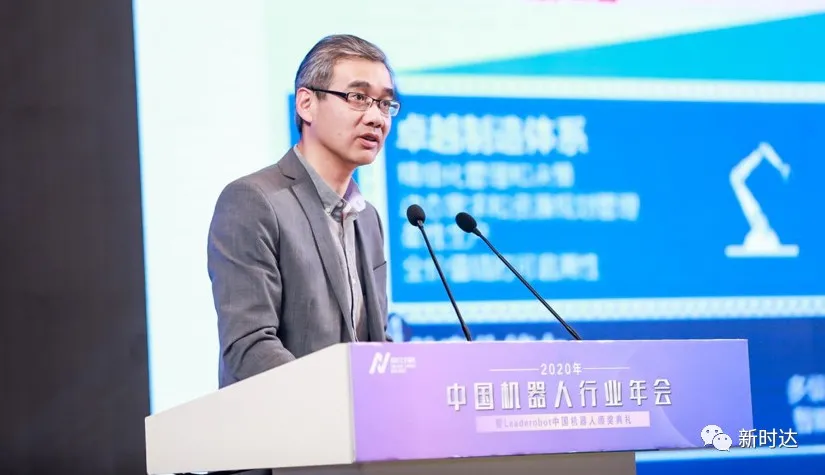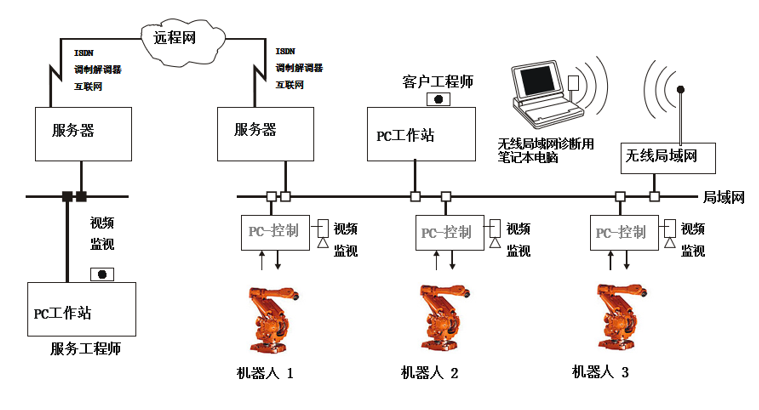Driving intelligent manufacturing of robots, how far has STEP's digital twin exploration gone?
- Views:
- Time of issue:2021-02-19 15:11
Driving intelligent manufacturing of robots, how far has STEP's digital twin exploration gone?
- Views:
- Time of issue:2021-02-19 15:11

Cai Liang, Deputy General Manager of STEP
This article is based on the content of STEP Deputy General Manager Cai Liang's speech at the China Robot Annual Conference, provided by the Robot Lecture Hall.
More and more robots are enlarged into intelligent manufacturing. Robots are the core of intelligent manufacturing. In the future, factory robots will take over everything. Therefore, robots must adapt to the development direction of intelligent manufacturing.
Digital twins have a very large impact on smart manufacturing. From the perspective of the development direction of intelligent manufacturing, driven by the entire vision, the digital twin consists of the three main points of excellent manufacturing system, full-scenario customer value, and innovative business model, as well as the two basic points of digital capabilities and organizational capabilities. The core elements of industry transformation and upgrading.
Among them, the excellent manufacturing system is the foundation. The excellent manufacturing system includes refined management and decision-making, dynamic demand and supply planning management, flexible production, and traceability of the entire value chain; full-scenario customer value is mainly from the perspective of customers, through personalized user experience and digital product traceability and new sales channels to create new value; innovative business models refer to upstream and downstream collaboration, service-oriented manufacturing, C2B, industrial chain platforms, etc.
Digital capabilities are also very important, including a unified data governance system, multi-level collaborative industrial Internet architecture, cloud-based service system platform, and intelligent manufacturing technology platform; organizational capabilities include dedicated digital project implementation teams, leadership and agility organization, digital talent training program, etc.
Full value chain construction
At present, robot integration has shown three major trends: digitization, informatization, and networking. Therefore, the construction of the whole value chain is very critical.

The whole value chain construction model is simple to understand, that is, the process of order manufacturing and delivery from the manufacturing end. The order delivery process and order acquisition process are completely different from the direct end-to-end manufacturing method. At present, it seems to be an important process for the transformation of traditional manufacturing to intelligent manufacturing.
The so-called intelligent manufacturing of the whole value chain is to cope with changes in production and manufacturing scenarios. Its important conceptual change is that enterprises not only produce enterprise orders, but customer orders can also come directly from a certain end user. From the perspective of the Internet and e-commerce, consumers are actually the real terminals. Because the improvement of Internet informatization has made the process efficiency and transparency of the entire manufacturing process more and more improved, so the work that starts at the manufacturing end in the future, It often starts with consumer demand, and finally develops into a model in which enterprise manufacturing is directly connected to the terminal.

Therefore, the entire intelligent manufacturing and ecological chain will undergo tremendous changes in the future. Enterprises need to consider customer value in all scenarios including personalized user experience, digital product traceability, and customer access channels. In the entire value chain, information flow and logistics are undoubtedly the most important things. To put it simply, the future intelligent manufacturing is also the realization process of delivering from raw materials to end products directly to consumers. But under the current situation, although the entire information chain has played a great role, it is actually still not so smooth.
Based on this idea, the future business model and business model will inevitably undergo tremendous changes. Cai Liang pointed out that the concept of Ali's rhino platform was well known some time ago, and it is a very thorough M2N model. Under this manufacturing model, the manufacturing end needs to consider how to adapt to changes in demand, and the information system, manufacturing system, delivery system, and financial system also need to consider how to keep up with changes in demand. Intelligent manufacturing brings changing demands. For enterprises, how to build digital technology also involves many aspects. However, in order to meet the demands, digital capabilities are the foundation, and the information flow needs to be smoother. Once one of the links cannot be completed, it will be a castle in the air.
In addition, the entire organizational model will change. The entire organization will think about how to realize the construction of M2N architecture to ensure the transformation of the intelligent manufacturing model. Therefore, the corresponding supporting personnel capabilities, personnel deployment methods, incentive models and business models will also change.
Robotics and Intelligent Manufacturing
Robots are a very important link in intelligent manufacturing, and it has become a consensus that robots will replace humans in the future. Cai Liang believes that under the epidemic situation in 2020, the demand for robots will be greatly relaxed, which also proves the status of robots in intelligent manufacturing. But now it is also found that the upgrading of traditional manufacturing to intelligent manufacturing is not only restricted by the cost factor that most people thought at the beginning, but the entire manufacturing model is essentially unable to meet the requirements of special circumstances.

But Cai Liang also pointed out that if the robot wants to take over everything, the basic technology of the robot must be improved. Human beings need intelligent robots, including the addition of visual and tactile senses that are closer to human beings, and can provide information feedback to the surroundings. After information channels come in, the robot can make autonomous feedback. This is an intelligent robot.
"Does the presence of robots mean that the entire intelligent manufacturing has changed? Not necessarily." Cai Liang said, "Because all the information channels are not as simple as one person sees, and there is also a summary of the entire value chain information. First collect and then flow, disassemble It can understand every aspect of manufacturing, so robots are in charge of everything, and there is a need for information sources and channels for the entire information guarantee.”
In the entire manufacturing process, there is actually a basic intelligent manufacturing model, and how to incorporate informatization, digitalization, and physicalization processes is still a difficult point.
Starting from the design end, the information flow comes in and then proceeds to simulation, to virtual realization, and then to delivery and realization. Under this scheme, an all-round module architecture is required, so as to further extend the subdivision field. The model under this theory still has defects. For example, many uncontrollable changes will occur in actual manufacturing. For example, the model often only includes the engineering end to the delivery end. There is still a lot of homework to be done on how to build the front-end architecture. Therefore, most companies are still groping and trying Practice.
Application of digital twin technology
Therefore, Cai Liang believes that the so-called digital twin technology is the link of informatization and virtualization that can correspond to the actual scene, and what you see is what you get to build intelligent manufacturing.
Cai Liang used a video to show a practical case of how the factory can be deployed and how the structure can be seen by STEP in the virtual scene. He believes that through digitalization, enterprises can simulate the effects of production in smart factories, and can realize interaction from manufacturability, economic production efficiency improvement, virtual commissioning, entire logistics design and on-site virtual-real linkage of digital equipment, plus the entire line The comprehensive support of the fast physics engine improves the implementation accuracy from the design quality and design efficiency.
Among them, virtual trial operation is an electrical debugging technology based on digital simulation technology. It can complete the joint debugging of PLC program and robot program through the combination of simulation environment and physical PLC, HMI and other automation equipment, and realize the early verification of design and program before construction, thereby reducing risk costs and improving project quality.
Virtual debugging technology can debug PLC code in a virtual environment. By simulating and verifying automation equipment in a virtual way, it can ensure that the performance of the equipment can meet expectations, and then download these codes to the real equipment, which can greatly shorten the on-site debugging cycle.
While trying these new digital twin technologies, STEP also adopted 3D scanning technology to try to directly restore the on-site environment. The 3D scanning tool is also a visual tool to scan the normal range and readjust the factory structure. Through reverse engineering, the enterprise digitally simulates the smart factory architecture on the original basis. Through the 3D modeling of the scanning center, STEP can compose the basic 3D model, which is more efficient than manual restoration and design in the transformation of old factories.

After 3D scanning, the 3D modeling of the entire plant structure can be re-architected into a virtual smart factory architecture. "In the future, when designing factories, we will gradually enter into this mode. With 3D scanning modeling, equipment modeling can be put in at the same time, and a smart factory design that is very close to the reality can be obtained." Cai Liang explained.
But the completion of the design does not mean the end. Under such a model, STEP also tries to conduct a virtual test run, so that it can judge whether the installation of each equipment and component is in line with the actual situation, and whether it can meet the requirements for a test run. By working in the virtual debugging experimental environment, STEP can also generate corresponding program codes under the virtual environment, which can be directly used in practical applications in the future.

According to Cai Liang, STEP has also begun to try virtualization design in small projects, and has obtained very good practical application results.
In the future, data aggregation will play an increasingly important role in the maintenance and improvement of equipment in the future. Enterprises grasping operational data will directly produce and improve data, which is also the basis for extensively improving refined management of equipment targets.
Scan the QR code to read on your phone


